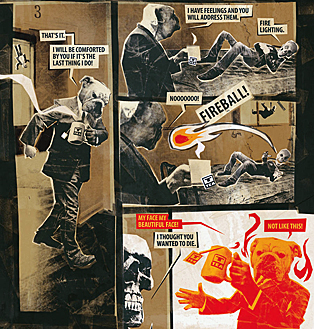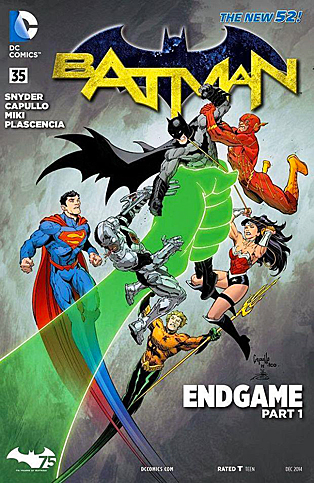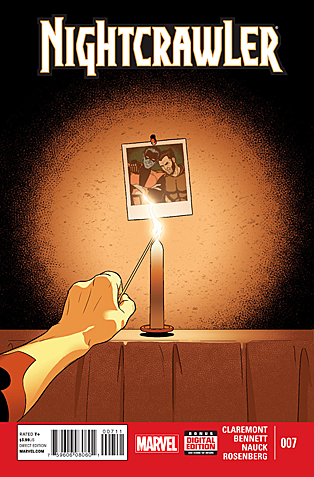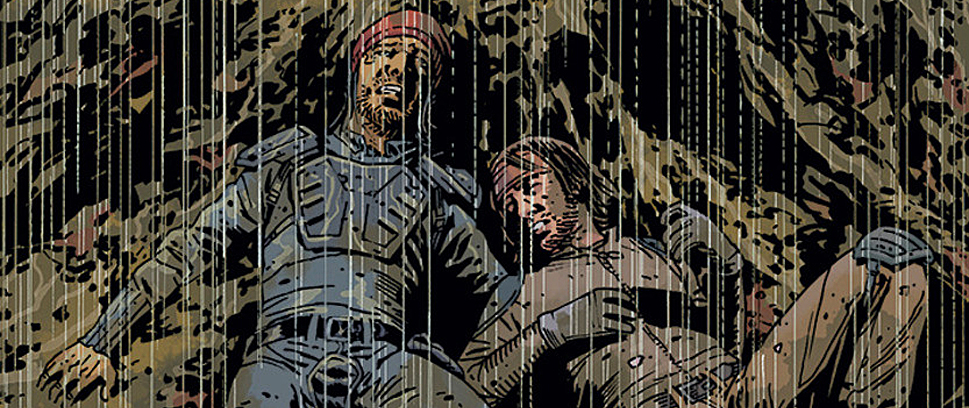
Last Week’s Comics 10/15/2014
Punks: The Comic #1
(Image – writer: Joshua Hale Fialkov; artist: Kody Chamberlain)
Punks: The Comic is like a walk through an insane person’s mind. And it’s awesome.
Joshua Hale Fialkov and Kody Chamberlain revive their cult series, Punks, this time bringing their brand of oddity to Image Comics. The issue is a mashup of arbitrary jokes – from the pantsless Dog being stuck in the ceiling amid a troupe of Garden Gnomes to the Punks card game placed in the middle of the comic – but the whimsy works because of the copious amounts of laugh-out-loud humor. In a world of increasing randomness for randomness sake (see Family Guy), it’s nice to see something that is random, but also wholly entertaining.
 The main premise of Punks is that the melancholy Dog has met a girl and wants to introduce her to his friends. From there, we get ultra-protective Wunderpants, a bikini-clad woman with a dinosaur head and all sorts of oddities that are both weird and entertaining. Because even given its seeming lack of direction, Punks is well paced and well told, something that cannot be difficult especially given the indie nature of the comic.
The main premise of Punks is that the melancholy Dog has met a girl and wants to introduce her to his friends. From there, we get ultra-protective Wunderpants, a bikini-clad woman with a dinosaur head and all sorts of oddities that are both weird and entertaining. Because even given its seeming lack of direction, Punks is well paced and well told, something that cannot be difficult especially given the indie nature of the comic.
Punks includes part of the original story, found as an addendum to the comic. The first Punks comic, published in 2007, is odd randomness. The characters are all the same, but the humor isn’t as sharp. By placing this in their new series, Fialkov and Chamberlain show readers how much growth they’ve made as artists. The writing of the new Punks is more polished, and the jokes land with much better effect. The middle sequence of the book, where Dog encounters Gnomes living in his attack, is fantastically paced and easily the highlight of the comic.
Furthermore, in addition to Fialkov’s hilarious writing, artist Kody Chamberlain – who constructs Punks with no more than a photocopier, glue, tape and an X-Acto blade – provides the perfect visuals for Fialkov’s brand of peculiar humor. The cleverness of his constructs, though, it what makes Chamberlain such a skilled artist. I can’t imagine how difficult Punks must be to put together, but Chamberlain’s composition is superb. Everything solid about Fialkov’s writing is brought out in Chamberlain’s visuals, and it’s clear these two friends have a deep understanding for each other.
As an exercise in risk-taking, Punks is the indie comic that people need to be reading. It’s both entertaining and inspiring. Where most writers and artists would shy away from a pet project like Punks, Fialkov and Chamberlain – as well as Image Comics – bring the weirdness to life. I will be picking up Punks #2, despite the comic closing with Abe Lincoln’s warning about crass consumerism, and I recommend you pick up Punks as well. It’s definitely an experience worth having.
———
Wytches #1
 (Image- writer: Scott Snyder; artist: Jock)
(Image- writer: Scott Snyder; artist: Jock)
Easily one of comics’ star writers, Scott Snyder delivers a new take on an old favorite with Wytches. As an essay in the back of the comic explains, “[The Wytches are] huge and ancient and primal and deeply evil. They have a knowledge of natural science that surpasses the limits of modern medicine. They have great power. They can give you alms for anything you want. And they’re out there, waiting for you to come see them. But first, you have to give them what they want.” So while they’ve only scratched the surface of these monsters in Wytches #1, Scott Snyder and Jock deliver a creepy, engrossing and utterly horrifying introduction just in time for Halloween.
To be clear, the comic is not without its faults. It’s a bit rushed in the pacing, as we get a lot of background for one book. Basically, Sail Rooks and her family relocated to New Hampshire after Sail was attacked by a bully. The girl, Annie, meets a horrifying end. But while no one believes that what Sail actually saw occurred, we know differently. Snyder is laying the groundwork for the series – and he does so with true skill – but the tradeoff is that Snyder rushes to a climax that doesn’t stick as well as it should.
That being said, everything else about the issue is solid. The characters are fully realized, even in the short space used to tell their story. You feel for Sail, and given the horror she’s seen, you get the desperation she feels in trying to explain herself. While Sail’s mother doesn’t get much time in the issue, her father, Charles, is the person to whom most readers will relate, especially those with children. His love for his daughter is palpable, and while we haven’t gotten past the first issue, we’re definitely attuned to Charles’ need to help his Sail, to keep her safe and to give her a fresh start. You can see a lot of Snyder putting himself in the story through Charles, who also happens to be a comic writer and illustrator.
Given the description of the Wytches in the essay, Jock is more than an appropriate choice to bring Snyder’s creation to life. We haven’t seen much creature design so far, but what Jock gives us – particularly in the flashback involving Sail’s abuser, Annie – is horrific in the best way. The more gruesome actions of the comic, including a deer coughing up its tongue, are offset by the more tame aspects, like a father’s conversation with his daughter. And this is the balance Jock can strike, going from violently graphic to emotionally painful, all in a manner of panels. Throw in Matt Hollingsworth’s moody colorization, and you have a book that raises the hair on the back of your neck on more than one occasion.
This kind of horror writing, akin to what we’ve seen Snyder do in Severed, is what modern horror seems to be missing. Instead of gore, Snyder goes for tone. The comic is creepy as hell, and thinking about it too much might keep you up at night. And if a comic can elicit that kind of response from its readers, it’s more than worth the price of admission. I can’t wait to see what happens when the Wytches finally make their appearance. If this first issue is any indication, we’re in for a nightmarish ride, one that I’ll be more than happy to have taken.
———
Batman #35
 (DC – writer: Scott Snyder and James Tynion IV; artist: Greg Capullo and Kelley Jones)
(DC – writer: Scott Snyder and James Tynion IV; artist: Greg Capullo and Kelley Jones)
The Joker is coming back? Intriguing!
Now that that’s out of the way, I can go back to wondering why I actually care that the Justice League is involved in this Bat-story. There’s a reason I don’t read Justice League-related books – they aggravate me, especially that ninny Aquaman. Bruce Wayne is chewing the fat with Alfred and Julia in Old Wayne Tower when he is visited by some of his Justice League pals. By visited, I mean assaulted.
Wonder Woman, Flash, Aquaman (who is disposed of quickest, making me smile) and Superman are set on taking Batman out, but he doesn’t know why. Luckily, Batman already has an armored suit that can take out most of the Justice League (as a point of pride, Batman does plan for all contingencies). Superman proves most problematic, but it’s Superman that reveals to us the trouble that’s brewing, as he’s first to show signs of Jokering via his Joker rictus grin.
I am very happy to see that Scott Snyder and Greg Capullo are still helming Batman. When I think of the Batman of today, I see Capullo’s depiction of both the people and city of Gotham. Snyder continues to keep things interesting each month, with his broad, expansive arcs and his ability to tie the extraneous Bat-verse (who is this Julia? And why haven’t I been reading Batman Eternal?) into this story without excessive exposition. But my real favorite part of this issue is the secondary story, “The Pale Man” (not least because I’ve always enjoyed Kelley Jones’ art).
Dr. Mahreen Zaheer is the victim of a home invasion by some Arkham Asylum escapees. They’re not looking to hurt Dr. Zaheer; they have a story to tell, or really five stories to tell. Apparently, Joker is having a contest, and whoever tells Dr. Zaheer the “right” story gets to live.
Tynion puts in time all over the Bat-verse, with typically satisfying results. Jones’ art uses heavy shadows and exaggerated expressions that work to great effect in this short tale. His depiction of the Joker here might be the scariest outside of when Capullo first revealed Joker wearing his own face as a mask.
Now on to the complaints: DC seems to be using this issue to hard-sell two weekly series: Batman Eternal and Futures End. After spending a year in “Zero Year,” I forgot how current Gotham is being shaped by the events of Batman Eternal. However, we don’t need a six-page ad for Futures End. This book is already long with the secondary story (something I am used to DC doing on both the Batman and Detective titles), but I don’t like it if this is justification for a higher cover charge (in the New 52, both Batman and Detective went from a $2.99 monthly to a $3.99 monthly when a second story was added, then stayed $3.99 when the second story went away. I hope that a $4.99 monthly cover charge is not on the horizon).
“Endgame” is off to a good start, and I’m confident Snyder can stay strong through the whole arc. “The Pale Man” makes for a good accompaniment, and I am looking forward to the remaining tales of the Arkham escapees. Batman will likely always remain a monthly purchase, but considering both time and cost, Batman Eternal and Futures End – I’ll have to catch up with you guys down the line.
———
Nightcrawler #7
 (Marvel – writer: Chris Claremont and Marguerite Bennett; artist: Todd Nauck)
(Marvel – writer: Chris Claremont and Marguerite Bennett; artist: Todd Nauck)
If there’s one X-Men issue to read this month, possibly this year, it’s Nightcrawler #7. I haven’t been following the whole “Death of Wolverine” storyline, and to be honest, Nightcrawler has been the only X-book I’ve been regularly reading. The series has had a mournful tone to begin with, due to the circumstances that brought Kurt back from the dead. In addition to Logan’s death, a whole era of a beloved comic book franchise is mourned in this issue. Who better to script it than Chris Claremont, the man who steered the ship for 15 years and brought us many of the moments shown in flashback in this issue.
Kurt Wagner has had a lot to process in his time back on earth – the death of his love Amanda and his inability to return to heaven being chief among them. Now his best friend is dead. I have mentioned in past reviews how Chris Claremont has been able to successfully pull off these one-issue Nightcrawler stories with the same skill as he was able to do in between numerous epic X-Men storylines during the golden age of the franchise. Much like Nightcrawler, he’s been away from the X-Men world for a while, and with this comic he has taken opportunities to comment on where the franchise is at the moment, and also effortlessly provide us windows into the minds of these complex and beloved characters.
With the plotting assistance from Marguerite Bennett in this issue, we are taken through a condensed history of Nightcrawler’s time knowing Wolverine, which in turn is a condensed history of the golden age of the X-Men. We see them fighting Krakoa, “The Dark Phoenix Saga,” the “Mutant Massacre” and a number of little moments that Kurt and Logan have shared over the years. In this one issue I feel like more weight and sentiment is put into this story than anything I could possible retain from the actual “Death of Wolverine” storyline itself (but more on that later).
Todd Nauck’s art has this amazing ability to evoke the past, present and somehow the future when we’re taken on this sentimental trip. There’s even an almost full-page panel that is credited to the great artists of X-Men, including John Byrne, John Romita Jr. and Marc Silvestri. These are all nice touches in a book that is essential for anyone who has cared about the X-Men. You really feel Kurt Wagner’s frustration and heartbreak when he cannot bring Logan back for a party he creates for him in the Danger Room, with all of Logan’s friends in the Marvel Universe in attendance. I admit that I share Kurt’s frustration and heartbreak, mainly because of how Marvel has overused Wolverine in the past 25 years, and as a result it’s led to ending the run of a great character.
While I barely know what’s up currently in the other X-Men comics, reading this I didn’t feel lost at all. This is an issue about the characters, something that I feel the Big Two have lost in this age of writing for the trades and propping up potential characters and storylines for future movies. It is that propping up of characters that leads me to believe there may be some finality to this. While I doubt Wolverine’s dead forever, what if?
In a recent Nerdist Comics Panel interview, Chris Claremont mentioned that Marvel is trying to limit the creation of new characters in the X-Men books, so that they’re basically not giving characters away for free to the X-Men movies being put out by Fox. It’s almost certain that the once flagship Fantastic Four comic will end for good in 2015, also due to the fact that Marvel CEO Ike Perlmutter doesn’t feel the need to support characters in movies not being released by Marvel Studios. X-Men is still a big seller in comics form, but with the success of X-Men: Days of Future Past there’s little likelihood that Marvel will retain the rights to the X-Men characters, even in the next decade. So again, what if they’re trying to sabotage the X-Men comics by killing off major characters?
Only time will tell. It will be a shame if Marvel minimizes the X-books and screws around with the creative quality due to the bottom line, but that’s pretty much been the way the cookie crumbles in the comics world for decades. Up until this issue I can’t say the death of Wolverine has had much of an effect on me. After reading this issue, it’s really got me thinking: what does the future hold for the X-Men? Hopefully more, because despite how mournful and retrospective this issue is, by then end there’s a sense of hope, as their always is at the conclusion of the greatest X-Men sagas. As Kurt joins his longtime friend and teammate Rachel Summers to meet up with the rest of the X-Men, he (and Chris Claremont) leave us with this thought about moving on:
“Out of the houses of the dead… and into the world of the living.”



